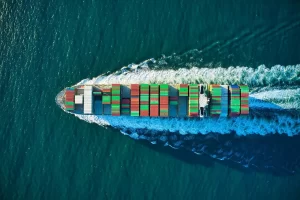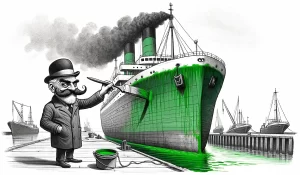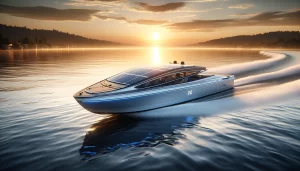Ports serve as a natural concentration of energy demands from a variety of ships, trains, and ground vehicles. As electrification and low-carbon fuel become more widespread, it will drive an unprecedented increase in energy demand at ports globally. Understanding the key drivers of this seismic energy shift is essential if our ports are to become the energy hubs they need to be for deep decarbonization.
If we focus solely on the maritime activities at a port, electrification of cargo-handling equipment and vessels, cold-ironing, and e-fuel production will be the major demand drivers for electricity. Read on to learn more about the impact of each on port electrification.
Electrification of Cargo-handling Equipment
Cargo-handling equipment (CHE) includes rubber tire gantry cranes, forklifts, container cranes, and other machinery used to move cargo around the port complex. The traditional way these machines are powered is by internal combustion engines running on gasoline or diesel fuel. With the current pressure on ports to reduce emissions, CHE is usually at the top of the list for decarbonization.

Fortunately, some, if not all, CHE is suitable for electrification or hybridization. Indeed, ports are already adopting hybrid or all-electric CHE; look at the Ports of Long Beach, Seattle and Tacoma, Rotterdam as examples. Once electrified, these vehicles reduce port emissions and fuel costs, but they also increase port electricity demand. As an example a single gantry crane might consume around 250 kWh per day, and a single port may have 100 gantry cranes. A fleet of all-electric CHE can quickly add-up.
Cold-Ironing Vessels
The vast majority of energy consumed by a ship is used to propel a vessel through the water, but energy is still required even when a port is stationary at the dock. Many large commercial vessels will continue to use fuel to power the ship’s diesel generator engines that produce electrical power for cargo pumps, ventilation fans, lighting, and other equipment.
Instead of burning fuel in engines to produce electrical power, ships can plug into the electrical grid on-shore and turn off their engines. This is sometimes referred to as cold-ironing, or going on shore-power. While the practice is not yet widespread, it is becoming more common across the world. California even has an ‘At-Berth’ regulation that requires certain vessels to go on shore-power while calling in ports within the state and other states are considering similar measures. To see other ports that provide shore-power capabilities, take a look at this assessment from the EPA.

The electrical power requirements of a vessel while in port depend on the vessel type and it’s cargo, but they can be substantial. As an example, Carnival Cruise Lines states that a single cruise ship requires around 10 megawatts of power while at the dock, or approximately 12 gigawatt-hours annually. Large ports that service multiple vessels simultaneously will need to be able accommodate these massive electrical loads.
Vessel Electrification
There was a time when an all-electric ship was relegated as a research novelty, something too expensive to ever actually use in commercial applications. Not anymore. Hybrid and all-electric ships are hitting the water throughout the world in both the commercial and recreational maritime markets. This is due in large part to improvements in battery manufacturing, advanced materials, and novel battery chemistries which have resulted in cheaper and more energy dense batteries. Just look at this growth in electric ships in the figure below.

Commercial vessels that tend to lend themselves to all-electric operations are those that have relatively short trips between destinations; are frequently in or near a port; and can have ship space for batteries. Vessel types that are actively being electrified include ferries, tugs, push boats, and even container ships.
Just like an EV, an all-electric ship will need to recharge its batteries periodically. Ship recharging, like cold-ironing, could be substantial electrical load, even for a single vessel. One potential difference however is that the large commercial vessels going on shore-power are likely to be in port for many hours or days, whereas an electric vessel is likely to be at the berth for fractions of an hour. With such a limited time to recharge, ship batteries will need ultrafast charging, which means high power.
Hello Hybrid Ferries
Take the M/V Wenatchee, one of 21 vessels in the Washington State Ferries fleet that are being converted to plug-in hybrids. This single vessel is going to have a 5,700 kilowatt-hour (kWh) battery system; for comparison a Tesla S battery pack is about 100 kWh. This vessel only has about 15 minutes to charge on either end of its voyage and during that time it will require approximately 10 megawatts of power. If multiple ships are recharging in-port at once, it’s easy to see how these electrical loads add up.

Washington State Ferries Hybrid-Electric Olympic Class Ferry. Source: Vigor Industrial
E-Fuel Production
A lot of vessels and CHE equipment can be electrified, but for larger vessels and CHE it’s just not practical with current technology. For those vessels and CHE that can’t be electrified but which still need to reduce emissions, there are low- and zero-carbon liquid fuels. A variety of fuels are emerging as viable alternatives to diesel and heavy fuel oil for the maritime industry, including: methanol, hydrogen, ammonia, and some biofuels.
Some of these fuels can be produced through electrochemical conversion pathways, such as using electrolysis to produce hydrogen. When a fuel is produced through such methods they are often referred to as electrofuels, or e-fuels. A number of ship owners and operators are investigating these e-fuels. For example, in 2021 Maersk spent $1.5 billion on eight new containerships and they also announced a supplier of e-methanol.
E-fuels could be produced almost anywhere and then transported by truck or pipeline to where they are needed. However, given the current cost premium associated with these fuels, the economics suggest that producing fuel near where it’s needed could make the numbers pencil out more favorably. In which case it’s likely we’ll see at least some e-fuel production at the port.
The E in E-Fuels means Electricity
Producing e-fuels requires electricity of course. According to this study from IRENA, producing a ton of e-methanol requires approximately 11 megawatt-hours of electricity (assuming the CO2 is provided).
Large commercial vessels need tremendous amounts of energy. It’s common for a typical container ship to consume over two hundred tons of heavy fuel oil every day at normal cruising speed. If we assume an ocean-going vessel bunkers 3,000 tons of heavy fuel oil between voyages, the energy equivalent amount of methanol would be approximately 6,000 tons.
Refueling this one ship with methanol ten times a year would require somewhere north of 600,000 megawatt-hours of electrical energy for e-fuel production. That’s equivalent to the energy consumed by 60,000 American households each year. Maybe now is a good time to note that there are around 50,000 commercial ocean-going vessels in the world.
Ports as Energy Hubs
These four demand drivers will cause significant increases in electricity consumption at the seaports throughout the world in the coming years. It’s impossible to say with any certainty how much, or when, demand will increase due to these drivers, but model forecasts offer a glimpse of potential future scenarios. According to one study that forecasted electricity demand across 53 of the U.K.’s major ports, demand could increase from approximately 20 gigawatt-hours in 2016 to as much as 4,000 gigawatt-hours by 2050 under an aggressive decarbonization scenario. And that doesn’t even consider e-fuel production.

The energy transition is going to reshape many industries and maritime is no exception. To handle these new electrical loads requires investments in such things as grid infrastructure, energy storage, and microgrids. These infrastructure investments in port electrification don’t happen overnight. Sometimes they can take decades to complete. To best prepare for the future, ports, terminals, and the electric utilities that serve them should begin to prepare for this transition as soon as possible.




